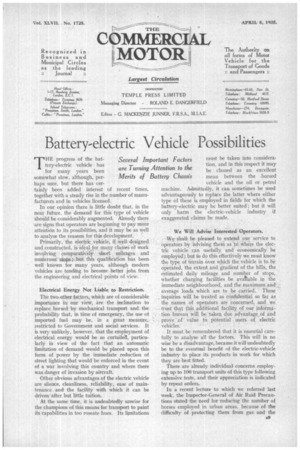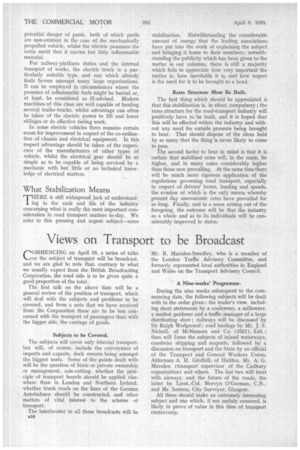Battery-electric Vehicle Possibilities
Page 43

Page 44

If you've noticed an error in this article please click here to report it so we can fix it.
Several Important Factors are Turning Attention to the Merits of Battery Chassis
THE progress of the battery-electric vehicle has for many years been somewhat slow, although, perhaps sure, but there has certainly been added interest of recent times, together with a steady rise in the number of manufacturers and in vehicles licensed.
In our opinion there is little doubt that, in the near future, the demand for this type of vehicle should be considerably augmented. Already there • are signs that operators are beginning to pay more attention to its possibilities, and it may be as well to analyse the reasons for this development.
Primarily, the electric_ vehicle, if well designed and constructed, is ideal for many classes of work involving comparatively short mileages anti =herons steps; but this qualification has been well known for many years, although modern vehicles are tending to become better jobs from the engineering and electrical points of view.
Electrical Energy Not Liable to Restriction.
The two other factors, which are of considerable importance in our view, are the inclination to replace horsed by mechanical transport and the probability that, in time of emergency, the use of imported fuel may be, in a great measure, restricted to Government and social services. It is very unlikely, however, that the employment of electrical energy would be so curtailed, particularly in view of the fact that an automatic limitation of demand would be placed upon this form of power by the immediate reduction of street lighting that would be enforced in the event of a war involving this country and where there was danger of invasion by aircraft.
Other obvious advantages of the electric vehicle are silence, cleanliness, reliability,, ease of maintenance and the facility with which it can be driven after but little tuition.
At the same time, it is undoubtedly unwise for the champions of this means for transport to paint its capabilities in too roseate hues. Its limitations must be taken into consideration, and in this respect it may be classed as an excellent mean between the .horsed vehicle and the oil or petrol machine. Admittedly, it can sometimes be used advantageously to replace the latter where either type of these is employed in fields for which the battery-electric may be better suited ; but it will only harm the electric-vehicle industry if exaggerated. claims be made.
We Will Advise Interested. Operators.
• • We-shallbe pleased to ,extend our service to operators by advising them as to where the electric vehicle can usefully and economically be . employed.'; but to do this effectively We must know the type of terrain over which the vehicle is to-be. operated, the extent and gradient of the hills, the estimated daily mileage and number of stops, whether charging facilities be avatable in the immediate neighbourhood, and the maximum and . average loads which are to be carried. These inquiries will be treated as confidential so far as the names of operators are Concerned, and we'. trust that this, additional facility of Our information bureau will be'taken, due advantage, of And prove .or value to .pOtential users. of. 'electric vehicles. • .
It must be remembered that it is essential carefully to analyse all the factors. This will in no wise be a disadvantage, because it will undoubtedly be to the eventual benefit of. the electric-vehicle industry to place its products in work for which they are best fitted.
There are already individual concerns employing up to 100 transport units of this type following extensive tests, and their appreciation is indicated by repeat orders.
In a recent lecture to which we referred last week, the Inspector-General of Air Raid Precautions stated the 'need for reducing the number of horses employed in urban areas, because of the difficulty of protecting them from gas and the potential danger of panic, both of which perils are non-existent in the case of the mechanically propelled vehicle, whilst the electric possesses the extra merit that it carries but little inflammable material.
For railway-platform duties and the internal transport of works, the electric truck is a particularly suitable type, and one which already finds favour amongst many large organizations. It can be employed in circumstances where the presence of inflammable fuels might be barred or, at least, be considered as ill-advised. Modern machines of this class are well capable of hauling several trailer-trucks, whilst advantage can often be taken of the electric power to lift and lower stillages or do effective tiering work.
In some electric vehicles there remains certain room for improvement in respect of the co-ordination of chassis and electrical equipment. In this respect advantage should be taken of the experience of the manufacturers of other types of vehicle, whilst the electrical gear should be so simple as to be capable of being serviced by a mechanic with but little or no technical knowledge of electrical matters.
What Stabilization Means
ffiHERE is still widespread lack of understand ing in the rank and file of the industry concerning what is really the most important consideration in road transport matters to-day. We refer to this pressing and urgent subject—rates stabilization. Notwithstanding the considerable amount of energy that the leading associations have put into the work of explaining the subject and bringing it home to their members ; notwithstanding the publicity which has been given to the matter in our columns, there is still a majority which fails to appreciate how very important the matter is, how inevitable it is, and how urgent is the need for it to be brought to a head.
Rates Structure Must Be Built.
The first thing which should be appreciated is that this stabilization is, in effect, compulsory ; the rates structure for the road-transport industry will positively have to be built, and it is hoped that this will be effected within the industry and without any need for outside pressure being brought to bear. That should dispose of the ideas held by so many that the thing is never likely to come to pass.
The second factor to bear in mind is that it is certain that stabilized rates will, in the main, be higher, and in many cases considerably higher than those now prevailing. At the same time there will be much more rigorous application of the regulations governing road transport, especially in respect of drivers' hours, loading and speeds, the evasion of which is the only means whereby present day uneconomic rates have prevailed for so long. Finally, and in a sense arising out of the foregoing, the outcome will be that the industry as a whole and as to its individuals will be considerably-improved in status.






















































































































